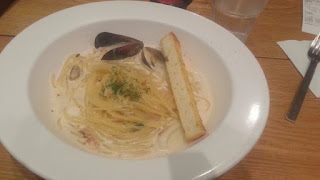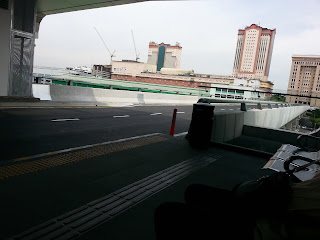Free Traditional Alcohol Gallery
11th of Feb
Today, we went to visit around Seoul National University (SNU) and have a short Korean classes taught by our OCs. Before we started our class, we got to have light lunch in the convenience store in the university. By light lunch, what I meant were ramyun and ice cream... While I did not eat ramyun but ice cream, my friends did. This fulfilled some of my friends', include my, wish to experience the life of Korean university students (wasn't referring to all students).
After the light lunch, we then headed to AIESEC SNU's "headquarter" to have a class on Korean. It was requested by us as some of us, including me, have not learned Korean before we arrived although some of us could understand some Korean after watching too many Korean dramas. Knowing a little Korean will help us to survive and experience Korean's life better, especially when ordering food. We were taught Hangul characters and some basic conversation in Korean such as self-introduction, buying things and so on.
After the class, we were all starving and after a short discussion, we decide to have dinner in one of the restaurants in SNU. It is an Italian restaurant and this mean that this was our first Western food in Korea!! The price are quite reasonable and this was what I ordered.
 |
| Seafood Cream Spaghetti |
It was sooooooo delicious (must either be I have not eat western food for long or they cooked it really good)! It was creamy and the seasoning was just perfect for me. The combination of the garlic bread and the cream were good too. Now that I'm back in Malaysia, I'm craving for it. How I wish I can go back to Korea again... <3 <3
12th of Feb
Besides archery, there was an activity which I was looking forward to - visiting to traditional alcohol gallery (Sool Gallery) in Insadong. Well, I wasn't really fond of drinking but it is another story if it is wine tasting. As we arrived, we were greeted with a table of different Korean alcohols.
Before the tasting started, we were given a brief introduction on the different alcohols made in Korea. Apparently the word 'sul', which means alcohol in Korean, is the combination of water 'su' and fire 'bul', so when you said it really quick, it becomes 'sul'. Why water? Why fire? According to the specialist during the talk, their ancestors could only see the bubbly effect when the water is boiled. However, when they mixed water, rice and yeast together, they witnessed the same bubbly effect and believed that there was fire in the water.
There are a few traditional alcohols in Korea, such as:
makgeolli - the 'youngest' or the 'freshest' alcohol as it is formed when it is just brewed, meaning that the time taken to ferment the alcohol is very short, which is why it needs to be kept in the refrigerator.
yakju - remains of makgeolli (meaning after many times of filtration), which made it purer than makgeolli. Sometimes, it is made of medicinal herbs.
soju - unlike the ones we can get in the store, the percentage of alcohol in those stores is way lesser as it has been diluted many times. In actual, the percentage is much much higher and it is distilled using a special pot.
Fruit wines - made up of different kinds of fruits such as apple, raspberry, omicha,...
So, after a short lesson, we were given the time to taste the different types of traditional alcohol. The professional of this industry also took an effort to mix some of their traditional wines for us to taste it. If I'm not mistaken, she mixed traditional soju, coffee and sugar. In this gallery, they have different themes of alcohol every month, which makes it an attraction as you can try different kinds of alcohol every month. Of course, some of my friends took this opportunity to buy some makgeolli as it costs like 3000 won per bottle, which is really cheap.
At the end of this visit, my face turned really red, even though I'm not drunk, which made me really embarrassed. Luckily, I'm not the only one.
After the wine tasting, we went to visit Kimchi Museum, which is located around the area. It costs 5000 won for adult but we enter anyway. The museum basically tell you everything you need to know about kimchi, from history, making process, the benefits of kimchi, the different containers used to make kimchi, different types of kimchi and so on. They even have a room where you can taste the kimchi itself. You can also join the kimchi making class but it is quite pricey. The visit was entertaining and it is interactive so it wouldn't be like the usual boring museum visit, which is suitable for kids.
Then, we were brought to eat dumplings. I was told that their dumplings are really famous and we couldn't wait for it. I ordered fried prawn dumplings and fish dumplings.
I personally like the fried prawn dumplings better than the fish one as it is really crispy and the prawn matched well with the inner fillings. The fish, however, did not suit my taste. The restaurant name is called Bukchonson Mandu and the location: Bukchonson Mandu. So, do go visit this restaurant if you are around Anguk or Insadong. Later, we have a walk in Ssamjigil, where they sell lots of traditional handmade souvenirs.
At night, we had a birthday surprise for one of my friends. It was all planned in a day and we did it in a rush. I was told about this plan in the morning and some of my friends went to a nearby market to shop for some ingredients. Before we had our mandu, some of us gave some excuses to leave early to cook something special for her. Then, something occurred. We were told that she had a plan with her friends and that made us so panic. Somehow, we made it and...
How can there be no seaweed soup when celebrating birthday in Korea? So yea, here were the seaweed soups made by one of my friends. It was her first time making it and our Korean OCs praised her for making it really good!!! Our birthday girl was in shock when she knew about it. Although we suspected her that she suspected something during the trip, but she said she wasn't and she was quite upset when nobody wished her (no wonder she was so quiet throughout the whole day). I can say it was quite a successful one then. Later, we had a little cake fight (you know, where one use the cream and messed up the birthday girl) and I practically ran away.
Before the tasting started, we were given a brief introduction on the different alcohols made in Korea. Apparently the word 'sul', which means alcohol in Korean, is the combination of water 'su' and fire 'bul', so when you said it really quick, it becomes 'sul'. Why water? Why fire? According to the specialist during the talk, their ancestors could only see the bubbly effect when the water is boiled. However, when they mixed water, rice and yeast together, they witnessed the same bubbly effect and believed that there was fire in the water.
There are a few traditional alcohols in Korea, such as:
makgeolli - the 'youngest' or the 'freshest' alcohol as it is formed when it is just brewed, meaning that the time taken to ferment the alcohol is very short, which is why it needs to be kept in the refrigerator.
yakju - remains of makgeolli (meaning after many times of filtration), which made it purer than makgeolli. Sometimes, it is made of medicinal herbs.
soju - unlike the ones we can get in the store, the percentage of alcohol in those stores is way lesser as it has been diluted many times. In actual, the percentage is much much higher and it is distilled using a special pot.
 |
| Photo taken from Google |
Fruit wines - made up of different kinds of fruits such as apple, raspberry, omicha,...
So, after a short lesson, we were given the time to taste the different types of traditional alcohol. The professional of this industry also took an effort to mix some of their traditional wines for us to taste it. If I'm not mistaken, she mixed traditional soju, coffee and sugar. In this gallery, they have different themes of alcohol every month, which makes it an attraction as you can try different kinds of alcohol every month. Of course, some of my friends took this opportunity to buy some makgeolli as it costs like 3000 won per bottle, which is really cheap.
At the end of this visit, my face turned really red, even though I'm not drunk, which made me really embarrassed. Luckily, I'm not the only one.
After the wine tasting, we went to visit Kimchi Museum, which is located around the area. It costs 5000 won for adult but we enter anyway. The museum basically tell you everything you need to know about kimchi, from history, making process, the benefits of kimchi, the different containers used to make kimchi, different types of kimchi and so on. They even have a room where you can taste the kimchi itself. You can also join the kimchi making class but it is quite pricey. The visit was entertaining and it is interactive so it wouldn't be like the usual boring museum visit, which is suitable for kids.
Then, we were brought to eat dumplings. I was told that their dumplings are really famous and we couldn't wait for it. I ordered fried prawn dumplings and fish dumplings.
 |
| Fried shrimp dumplings |
 |
| Fish fillet dumplings |
 |
| Ssamjigil |
 |
| TADA!! |




Comments
Post a Comment